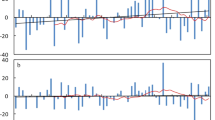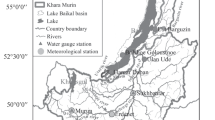Abstract
Urmia Lake, as one of the most valuable saline ecosystems in the world, has faced a sharp drop in the water level in recent years. The trend studies of climatic parameters can be effective in identifying the responsible factors and managing this crisis. This research investigated the frequency trend of daily precipitation in the ranges of less than 5 mm, 5–10 mm, 10–15 mm, 15–20 mm, and more than 20 mm in the Urmia Lake basin. The trend was assessed using Mann-Kendall, Spearman Rho and linear regression tests on 60 stations during a period of 30 years (1981 to 2011). The results showed that in all the three tests, the frequency of daily precipitation of less than 5 mm had a significant increase at 1% level. The 5–10 mm range displayed no significant trend, while the 10–15 mm range showed a significantly decreasing trend. The frequency in the 15–20 mm and above 20 mm ranges showed an insignificant falling trend. The analysis also indicated jumps in 1996 and 1999 (almost coinciding with the sharp drop in the lake’s water level). In other words, the frequency trends of daily precipitation with small amounts (as a result, high evapotranspiration loss) were increasing and with large amounts were decreasing. This can be a contributor to reduced run-off and, hence, decreased water entering the lake. The results emphasize the need for changes in the management and consumption of water resources in the basin, in order to adapt to the climatic change.




Similar content being viewed by others
References
Ahmad I, Tang D, Wang T, Wang M, Wagan B (2015) Precipitation trends over time using Mann-Kendall and Spearman’s rho Tests in Swat River Basin, Pakistan. Adv Meteorol 2015. doi:10.1155/2015/431860
Amirataee B, Zeinalzadeh K (2016) Trends analysis of quantitative and qualitative changes in groundwater with considering the autocorrelation coefficients in west of Urmia Lake, Iran. Environ Earth Sci 75:371. doi:10.1007/s12665-015-4917-2
Bandyopadhyay A, Bhadra A, Raghuwanshi NS, Singh R (2009) Temporal trends in estimates of reference evapotranspiration over India. J Hydrol Eng 14(5):508–515
Bostan AP, Akyürek Z (2007) Exploring the mean annual precipitation and temperature values over Turkey by using environmental variables. ISPRS: Visualization and Exploration of Geospatial Data, Stuttgart
Caprio JM, Quamme HA, Redmond KT (2009) A statistical procedure to determine recent climate change of extreme daily meteorological data as applied at two locations in Northwestern North America. Clim Chang 92:65–81. doi:10.1007/s10584-008-9474-1
Chen H, Guo SL, Xu CY, Singh VP (2007) Historical temporal trends of hydro-climatic variables and runoff response to climate variability and their relevance in water resource management in the Hanjiang basin. J Hydrol 344(3):171–184. doi:10.1016/j.jhydrol.2007.06.034
Chiew F, Siriwardena L (2005) Trend/change detection software and user guide, CRC for Catchment Hydrology, Canberra, Australia. Available at http://www.toolkit.net.au/trend
Delju AH, Ceylan A, Piguet E, Rebetez M (2012) Observed climate variability and change in Urmia Lake Basin, Iran. Theor Appl Climatol 111:285–296
Dinpashoh Y, Jhajharia D, FakheriFard A, Singh VP, Kahya E (2011) Trends in reference crop evapotranspiration over Iran. J Hydrol 399(3–4):422–433. doi:10.1016/j.jhydrol.2011.01.021
Dinpashoh Y, Mirabbasi R, Jhajharia D, Abianeh H, Mostafaeipour A (2014) Effect of short-term and long-term persistence on identification of temporal trends. J Hydrol Eng 19:617–625. doi:10.1061/(ASCE) HE.1943-5584.0000819
Eimanifar A, Mohebbi F (2007) Urmia Lake (northwest Iran): a brief review. Aquat Biosyst 3(5):1–8
Fan X, Wang M (2011) Change trends of air temperature and precipitation over Shanxi Province, China. Theor Appl Climatol 103(3–4):519–531. doi:10.1007/s00704-010-0319-2
Fathian F, Morid S (2012) Study of climate and hydrologic trends in Lake Urmia watershed using non-parametric methods. Iran J Soil Water Res 43(3):259–269 (in Persian)
Fathian F, Morid S, Kahya E (2014) Identification of trends in hydrological and climatic variables in Urmia Lake basin, Iran. Theor Appl Climatol 119(3):443–464
Fathian F, Dehghan Z, Bazrkar MH, Eslamian S (2016) Trends in hydrological and climatic variables affected by four variations of the Mann-Kendall approach in Urmia Lake basin, Iran. Hydrol Sci J 61(5):892–904
Feizi V, Mollashahi M, Frajzadeh M, Azizi G (2014) Spatial and temporal trend analysis of temperature and precipitation in Iran. Ecopersia 2(4):727–742
Ghahraman B, Taghvaeian S (2008) Investigation of annual rainfall trends in Iran. J Agric Sci Technol 10:93–97
Githui FW (2009) Assessing the impacts of environmental change on the hydrology of the Nzoia catchment, in the Lake Victoria Basin. Thesis (PhD). Vrije University Brussel
Golabian H (2011) Urmia Lake: hydro-ecological stabilization and permanence macro-engineering seawater in unique environments. Springer-Verlag, Berlin, pp 365–397. doi:10.1007/978-3-642-14779-1_18
Grayson RB, Argent RM, Nathan RJ, McMahon TA, Mein R (1996) Hydrological recipes: estimation techniques in Australian hydrology. Cooperative Research Centre for Catchment Hydrology, Melbourne, p 125
Han D (2007) Seasonal rainfall and flow trends within three catchments in south west England. In: Begum S, Stive MJF, Hall JW (eds) Flood Risk Management in Europe. Springer Netherlands, The Netherlands, p 275–292
Hassanzadeh E, Zarghami M, Hassanzadeh Y (2012) Determining the main factors in declining the Urmia Lake level by using system dynamics modeling. Water Resour Manag 26:129–145. doi:10.1007/s11269-011-9909-8
Hess A, Iyer H, Malm W (2001) Linear trend analysis: a comparison of methods. Atmos Environ 35(30):5211–5222. doi:10.1016/S1352-2310(01)00342-9
Hidalgo JCG, Bustins JAL, Stepanek P, Martin-Videb JM, Luisa M (2009) Monthly precipitation trends on the Mediterranean fringe of the Iberian Peninsula during the second-half of the twentieth century (1951–2000). Int J Climatol 29:1415–1429
Jahanbakhsh-Asl S, Ghavidel Rahimi Y (2003) Modeling of precipitation trend and drought prediction in Urmia Lake basin. J Soc Hum Sci 17(1):33–52 (in Persian)
Jalili S (2010) Spectral analysis of Urmia Lake level time series and impact of climate and hydrological variables on it. PhD dissertation, Tarbiat Modares University, Tehran, Iran (in Persian)
Jalili S, Kirchner I, Livingstone DM, Morid S (2012) The influence of large-scale atmospheric circulation weather types on variations in the water level of Lake Urmia, Iran. Int J Climatol 32(13):1990–1996. doi:10.1002/joc.2422
Kahya E, Kalayci S (2004) Trend analysis of stream flow in Turkey. J Hydrol 289:128–144. doi:10.1016/j.jhydrol.2003.11.006
Katiraei PS, Hejam S, Iran Nejad P (2006) Frequency changes and intensity of daily precipitation in trend precipitation of Iran during 1960 to 2001. J Geophys Space 33(1):67–83 (in Persian)
Kendall MG (1975) Rank correlation measures. Charles Griffin Inc, London
Kumar S, Merwade V, Kam J, Thurner K (2009) Stream flow trends in Indiana: effects of long term persistence, precipitation and subsurface drains. J Hydrol 374:171–183. doi:10.1016/j.jhydrol.2009.06.01
Kundzewicz ZW, Robson A (2000) Detecting trend and other changes in hydrological data. World climate programme—water, world climate programme data and monitoring, WCDMP-45, WMO/TD no. 1013. World. Meteorological Organization, Geneva
Mann HB (1945) Non-parametric test against trend. Econometrica 13:245–259
Masih I, Uhlenbrook S, Maskey S, Smakhtin V (2011) Stream flow trends and climate linkages in the Zagros Mountains, Iran. Clim Chang 104(2):317–338. doi:10.1007/s10584-009-9793-x
Mistry VV, Conway D (2003) Remote forcing of east African rainfall and relationships with fluctuations in levels of Lake Victoria. J Climatol 1(23):67–89
Mosmann A, Castro R, Fraile J, Dessens Sanchez JL (2004) Detection of statistically significant trends in the summer precipitation of mainland Spain. Atmos Res 70:43–53
Novotny EV, Stefan HG (2007) Stream flow in Minnesota: indicator of climate change. J Hydrol 334:319–333
Partal T, Kahya E (2006) Trend analysis in Turkish precipitation data. Hydrol Process 20:2011–2026. doi:10.1002/hyp.5993
Rezaei Banafsheh M, Sarafrozeh F, Jalali T (2011) Investigation of the trend analysis of extreme value of daily temperature and precipitation in Urmia Lake basin. J Geogr Plann (Tabriz Univ) 38(16):43–74 (in Persian)
Shadmani M, Marofi S, Roknian M (2012) Trend analysis in reference evapotranspiration using Mann-Kendall and Spearman’s rho tests in arid regions of Iran. Water Resour Manag 26(1):211–224. doi:10.1007/s11269-011-9913-z
Shahid S (2010) Rainfall variability and trends of wet and dry periods in Bangladesh. Int J Climatol 30:2299–2313
Shahid S (2011) Trends in extreme rainfall events of Bangladesh. Theor App Climatol 104(3–4):489–499
Sneyers R (1991) On the statistical analysis of series of observations. World Meteorological Organization. Technical note, No 143
Subramanya K (1998) Engineering hydrology, Tata McGraw-Hill, Second Edition. Tata McGraw-Hill Publishing Company Limited, New Delhi
Tabari H, Abghari H, Hosseinzadeh Talaee P (2012) Temporal trends and spatial characteristics of drought and rainfall in arid and semiarid regions of Iran. Hydrol Process 26(22):3351–3361
Wittenberg L, Kutiel H, Greenbaum N, Inbar M (2007) Short-term changes in the magnitude, frequency and temporal distribution of floods in the Eastern Mediterranean region during the last 45 years—Nahal Oren, Mt. Carmel, Israel. Geomorphology 84:181–191
Zereini F, Hötzl H (2008) Climatic changes and water resources in the middle east and north Africa. Springer Berlin Heidelberg, Berlin, p 552
Zhao G, Hormann G, Fohrer N, Zhang Z, Zhai J (2010) Stream flow trends and climate variability impacts in Poyang Lake Basin, China. Water Resour Manag 24:689–706. doi:10.1007/s11269-009-9465-7
Author information
Authors and Affiliations
Corresponding author
Appendices
Appendix A1
Appendix A2
Rights and permissions
About this article
Cite this article
Salehi Bavil, S., Zeinalzadeh, K. & Hessari, B. The changes in the frequency of daily precipitation in Urmia Lake basin, Iran. Theor Appl Climatol 133, 205–214 (2018). https://doi.org/10.1007/s00704-017-2177-7
Received:
Accepted:
Published:
Issue Date:
DOI: https://doi.org/10.1007/s00704-017-2177-7




